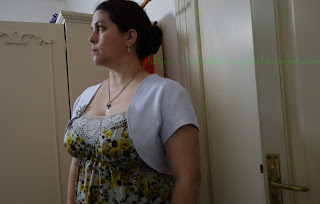Handsewn Late 16th Century Italian Style Chemise
By Lady Isabella D'Angelo
Figure 1 Close up of Chemise sleeves and embroidery
The chemise or camica was an undergarment worn by both men and women from the middle ages until fairly recently, historically.
It was made of either linen or cotton, with most extant garments being made of linen.
[i] The purpose of the garment was meant to have an undyed undershirt of sorts that could aborb the sweat and body oils, leaving the over garments clean.
No one wanted to clean their heavy wool or, if you were rich, heavy velvet garments every day; just as we today do not wash our winter coats every day.
The garments could be embroidered, typically using silk or linen thread.
Silk was domestically produced right here in Veneto between Vicenza and Verona.
[ii] Linen was common everywhere in the Old World.
The embroidery could be dyed or done with undyed silk – the latter called whitework.
Lace, which was only first developed in the 15
th century, could also be added.
[iii]
Extant examples
There are several extant examples of chemises from Italy located around the world. Some of these are embroidered, some to these are not. Both women and men would have their sleeves embroidered but, typically, only women had the bodies of the chemise with any decoration, if they wished.
Late 16th Century chemise at the Metropolitian Museum of Art in NYC
[iv]
Figure 2 is one example of a late 16
th Century Italian styled chemise.
The sleeves are heavily embroidered in purple silk and the body of the chemise is made up of thin panels that are then sewn together and the seams are embroidered over.
Because of the time it would take to make such a piece and the cost of the materials, this most likely belonged to an aristocrat.
Figure
3 Detail of a chemise with lace insertion, showing the upper part of the sleeve
[v]
Figure 3 shows the underarm and the sleevehead to a late 16th Century style chemise. Various laces are inserted between panels as well as around the neckline. This is similar to what I attempted to do with the chemise on display. The location of this extant chemise is currently unknown.
Figure
4 16th Century chemise close up showing needlework lace
[vi]
Figure 4 is not a true lace as we would know it today but a very specific type of embroidery called drawnwork.
The embroiderer would cut out some of the threads from the base fabric and wrap the remaining threads to create designs.
Figure 5 shows and example of needle work where it is half finished.
Figure
5 Sampler from the late 16th C/ Early 17th C showing various types of embroidery
[vii]
The mix of blue silk hippocampus and white bobbin lace I chose for the chemise comes from a few different embroidery examples.
Figure
6 Strip of blue embroidery with drawnwork, 16th C Italy
[viii]
Figure 6 is from the Metropolitan Museum of Art in New York City.
It shows a mix of light blue embroidered flowers with cutwork or drawnwork.
Figure 7 16th C textile showing lace insertion and dark blue silk embroidery
Figure 7 is closer to the techniques I used and shows both lace insertion and dark blue embroidery.
The base is linen with the blue thread embroidery being silk.
It is unknown what the textile itself was used for but most likely a table or alter cloth.

Figure 8 Seahorse or hippocampus, most likely done by Mary Queen of Scots
The hippocampus, or a mythical type of seahorse, was a popular motif throughout Europe in the late 16
th C.
Not only does is show up in various drawings of the time, but, in Figure 8, there is an extant embroidery of one.
The embroidery is attributed to either Mary Queen of Scots or Elizabeth Talbot, Countess of Shrewsbury.
[ix]
Technical Details
The main base of the chemise is linen. The embroidered bands in the sleeves are older – I did them almost a decade ago- which is why the color of the linen is slightly different. The bobbin lace is out of cotton. Both linen thread and silk thread were used to sew everything together.
 |
| Italian Chemise Pattern |
 |
Placement Guide
|
The above patterns aren't the best but it is pretty much what I used. (Ignore the orange pattern, it really is rectangular and not with a small bit cut out). The green is what I used for casing along the gathered neckline.
 |
| The Art Show where the finished chemise was first on exhibit |
 |
| Close up of the full exhibit |
 |
| Another close up of the embroidery |
[i] http://costumedabbler.ca/cotton
[ii] https://www.luigi-bevilacqua.com/en/silk-and-venetian-fabrics-renaissance/
[iii] https://owlcation.com/humanities/History-of-Lace-Making
[iv] https://www.metmuseum.org/art/collection/search/83860?&searchField=All&sortBy=Relevance&when=A.D.+1400-1600&what=Costume%7cLinen&ft=linen+embroidery+italian&offset=20&rpp=20&pos=29
[v] http://realmofvenus.renaissanceitaly.net/workbox/extcam6.htm
[vi] http://realmofvenus.renaissanceitaly.net/workbox/extcam5.htm
[vii] https://webapps.fitzmuseum.cam.ac.uk/explorer/index.php?qu=Name:sampler&oid=110905
[viii] https://www.metmuseum.org/art/collection/search/215421
[ix] http://collections.vam.ac.uk/item/O138524/the-oxburgh-hangings-panel-mary-queen-of/






















































